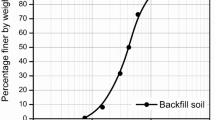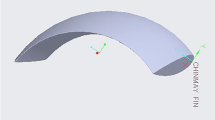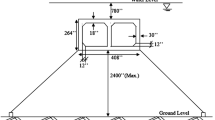Abstract
The objective of this study is to develop a procedure to analyze the motions of a floating pier comprised of several pontoons that are modeled as rigid bodies and connected to each other by flexible and rigid connectors. Recently, the use of floating piers has increased because of their advantages, such as faster and higher-quality construction, seismic force isolation for a full-scale mooring system, low dependence on local soil conditions and tides, ability to relocate or reconfigure the pier modules during the operation period and 75–100 years of repair-free service. A floating pier consists of a pier, access bridge, mooring system and fender system, each of which comes in many variations to suit different usages and construction considerations. The typical loads used in the design of these piers are dead loads, live loads, mooring loads, fender loads and environmental loads induced by wind, currents and waves. For numerical simulation, three types of piers are used: passenger piers, light-cargo piers and semi-heavy-cargo piers. The selected piers consist of several large pontoons joined by pivots and have a pile-based mooring system. These piers are modeled by SAP2000software as two-dimensional frames that are linked together. As the first step, each type of pier is subjected to loading, and its general behavior is assessed. According to this behavior, the major load combinations are described for the design of piers and analyzed to determine the behavior of the modules. Lastly, according to the analysis results and the safe use and stability considerations, such as the maximum draft and longitudinal gradient, the dimensions of each module in each pier type are presented.
Similar content being viewed by others
References
Wu J S, Shih P Y. Moving load induced vibrations of a moored floating bridge. Journal of Computers and Structures, 1998, 66(4): 435–461
Wu J S, Sheu J J. An exact solution for a simplified model of the heave and pitch motions of a ship hull due to a moving load and comparison with some experimental results. Journal of Sound and Vibration, 1996, 192(2): 495–520
Sheu Z F. The dynamic response of a floating body due to a moving load. Master Thesis. Tainan City: Cheng Kung University 2003
Tsinker G P. Floating Ports: Design and Constructions Practices. Texas: Gulf Publishing Company, 1986
Mirzaei A. Basic study of the floating pier behavior. Master Thesis. Tehran: University of Tehran, 2002 (In Persian)
Talee A. Modulation of floating piers regarding to environmental loads. Master Thesis, School of Civil Engineering, College of Engineering, University of Tehran, 2000 (In Persian)
Talee A, Bargi K. Modulation of floating piers regarding to environmental loads. In: Proceedings of the First Congress on Civil Engineering. NCCE, Sharif University of Technology, Tehran, 2002, Paper No. 83-1601 (In Persian)
Seif M S, Inoue Y. Dynamic analysis of floating bridges. Marine Structures — journal, 1998, 11(1–2): 29–46
Zhang J, Miao G, Liu J, Sun W. Analytical models of floating bridges subjected by moving loads for different water depths. Journal of Hydrodynamics, 2008, 20(5): 537–546
Huang E T, Chen H. Numerical simulation of dynamic responses of a floating pier in ship berthing operations. In: Proceedings of 16th ASCE Engineering Mechanics Conference. University of Washington, Seattle, 2003
Chen H, Huang E T. Ship berthing at a floating pier. In: Proceedings of the 13th International Offshore and Polar Engineering Conference. Honolulu, Hawaii, 2003
Mostofi A, Bargi K. New concept in analysis of floating piers for ship berthing impact, Marine Structures, 2012, 25(1): 58–70
Lwin M M. Design of the third lake Washington floating bridge. Concrete International: Design and Construction, 1989, 11(2): 50–53
Lee H H, Chen L, Weng W, Shyue S. The prediction of the dynamic and structural motions of a floating -pier system in waves. Ocean Engineering, 2007, 34(7): 1044–1059
Tajali Z, Shafieefar M. Hydrodynamic analysis of multi body floating piers under wave action. Ocean Engineering, 2011, 38(17–18): 1925–1933
Wang L, Sweetman B, Simulation of large amplitude motion of floating wind turbines using conservation of momentum. Ocean Engineering, 2012, 42: 155–164
Fakher A. Construction of Marine Structures Lecture Notes. School of Civil Engineering, College of Engineering, University of Tehran, 2012
Tsinker G P. Port Engineering: Planning, Construction, Maintenance and Security, New Jersey: John Wiley & Sons, 2004
Sorensen R M. Basic Coastal Engineering. 3rd ed. NY: Springer, 2005
Dean R G. R, Dalrymple R A. WaterWave Mechanics for Engineers and Scientists. Singapore: World Scientific, Advanced Series on Ocean Engineering, 2004
Author information
Authors and Affiliations
Corresponding author
Rights and permissions
About this article
Cite this article
Shahrabi, M., Bargi, K. Numerical simulation of multi-body floating piers to investigate pontoon stability. Front. Struct. Civ. Eng. 7, 325–331 (2013). https://doi.org/10.1007/s11709-013-0209-7
Received:
Accepted:
Published:
Issue Date:
DOI: https://doi.org/10.1007/s11709-013-0209-7




